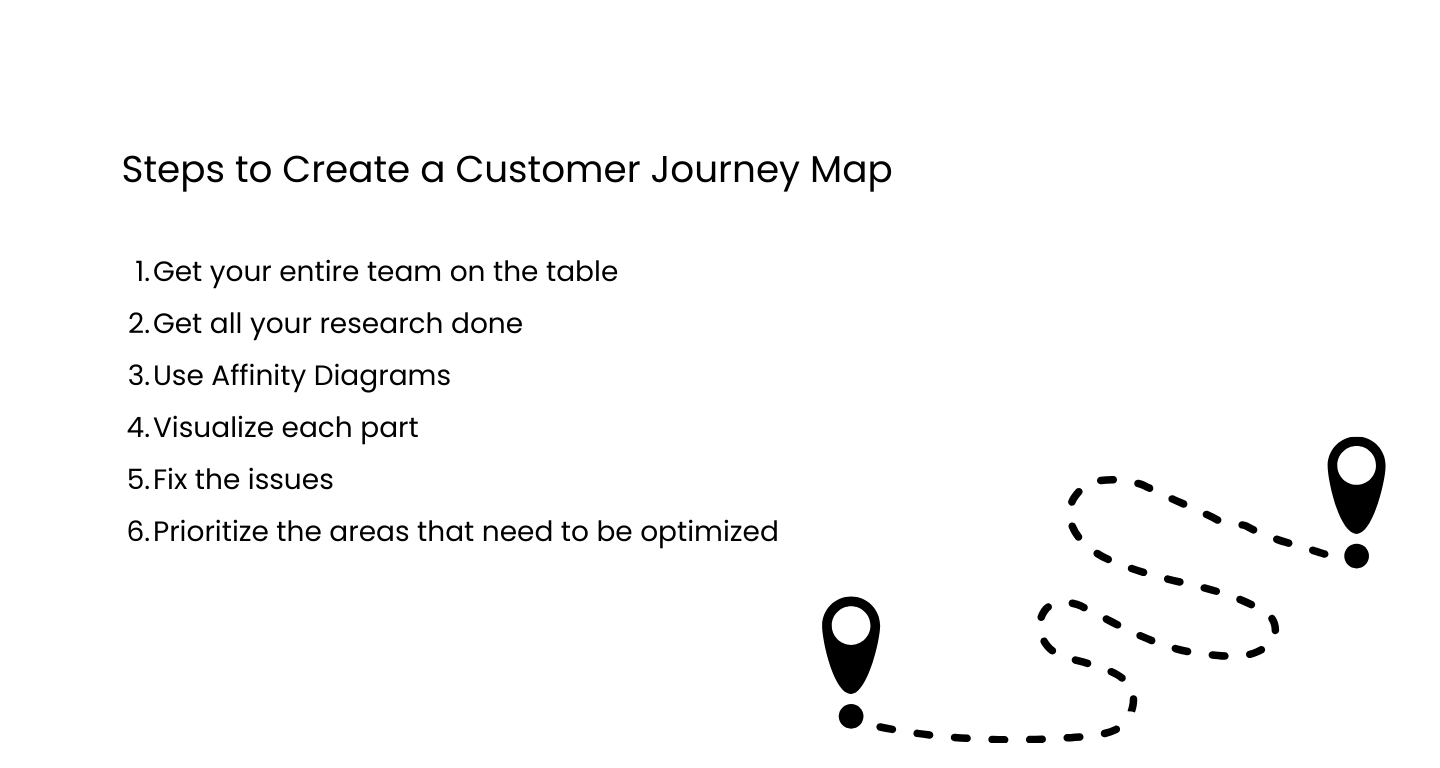Customer Experience
Customer Journey Map: Meaning, Types and Benefits
Article written by Mathew Maniyamkott
Regular contributor to various magazines. Passionate about entrepreneurship, startups, marketing, and productivity.
12 min read
29 January 2025

Every customer interaction with a business significantly affects its bottom-line satisfaction. And, most importantly, on its branding. This is why it is essential to have a Customer Journey Map. It helps mitigate potential mistakes you might make while interacting with your customers.
In this blog, we will look into the nuanced details of the customer journey, how to map it, its benefits, and all you need to know!
Before we dig deep into creating a customer journey map from scratch, here are some terms you need to familiarize yourself with.
What is a Customer Journey?
The Customer Journey is the customer’s entire interaction with a brand or service. It starts the moment a customer learns about your product or service. It can be from a friend or even an ad on the internet. So where does it end? Well, it shouldn’t, ideally. It continues until they think about the product and service they consume.
Airbnb is not a stranger to us. If you look at it, the brand has built itself on the foundation of trust. It focuses on customer experience to the fullest! It follows the customer’s journey to provide them with the utmost customer satisfaction. How? By utilizing feedback.
Moreover, in the case of Airbnb, it is a two-sided event. The host and the customer can rate each other on the website. That’s where they blur the lines between the brand and the customer!
What are the Stages of the Customer Journey?
What components will you focus on if you are going on a trip? There’ll be a starting point where you learn about a destination. Then, you’ll find a place to stay, places to visit, and the return journey. It is an entire process with a beginning, a middle, and an end. It’s just like a storyline.
Similarly, a customer journey includes four stages- Awareness, Consideration, Purchase, and Post-Purchase.
Now, let’s see what they are:
- Awareness: This is the first step when the customer comes to know about your product or service, maybe from their friends or family.
- Let’s say you are a SaaS platform. A customer looking for online survey tools comes across your product.
- Consideration: Now, they decide whether to avail of the service or invest in your product. Now, the customer will search for the best online survey tools to consider which one to spend on.
- Let’s say they search for a list of 14 best Online Survey tools and apps, and your product is listed. The customer clicks on your product and thoughtfully analyzes the pros and cons.
- Purchase: This is the ultimate decision made by the customer. To invest in your product or service. In our example, the customer clicks on the purchase option or signs up for your service.
- Post-Purchase: If you think the process ends when the customer buys your product, you are entirely wrong. It extends to when they think about you or enjoy your product.
- There’s one more important aspect when it comes to customer journey. It is when a customer turns into a brand advocate. This must be the ultimate aim of any organization.
Read More: 5 Stages of the E-Commerce Customer Journey
What is a Customer Journey Map?
A Customer Journey Map is a visual interpretation of the customer’s perspective of their relationship with the company across different periods and channels.
Several channels exist for your customers to interact with your product/service. In such a situation, they always expect a service that they can recommend to others.
A Customer Journey Map is a powerful tool for understanding and drafting the ideal customer experience. The journey map will show you the kind of communication the customer is receiving from any team in your organization and the kind of actions that you want the customers to take.
A Customer Journey Map is a powerful tool for you to understand and draft the ideal CX.
If you are looking for a tool to create one, consider SurveySparrow! It is more than just a tool. It can be your partner in creating great customer experiences. Moreover, you can track interactions everywhere, pay attention to every touchpoint, and customize it according to your preferences!
Join now to take your brand to the next level!

Explore Deeper Customer Insights with SurveySparrow
A personalized walkthrough by our experts. No strings attached!
Components of a Customer Journey Map
Let’s look at four major components that you must know:
1. Persona
This is probably one of the first terms you need to know if you are a student of Marketing (Cue: Segmentation). Your target persona is the set of attributes that you are looking for in the person you are targeting to sell your product/service.
Let us say you sell expensive suits. How do you create a persona for potential clients? If you look at it, there is no single persona as such. In fact, there can be multiple personas for a single product.
Ideally, you can expect C-suite executives to buy expensive suits. Their age would hover around 40 and above. They would live in upscale apartment complexes in metro cities with a spouse and have 1-2 kids. This is a customer persona. I hope you get the gist.
Why is identifying customer persona important? Understanding the motivations behind a customer of yours, buying your product, and other details will help you target better.
Remember, there is no set way a customer makes the purchase; there are interactions with different touchpoints, and not necessarily in the same order for every customer.
“Focusing on the customer makes a company more resilient.”
– Jeff Bezos
2. Touchpoint
- Any point of contact during a customer’s interaction with your brand is called a touchpoint.
- It could be a customer visiting your website, interacting with the chat console, buying a product, or talking to a customer service representative.
3. Moment of Truth
- A touchpoint that is considered crucial in the customer experience is called the ‘Moment of Truth.’
- At these points, as a business, you are in a position to focus and improve upon the customer experience.
- It includes identifying critical points where customer perceptions are significantly influenced.
4. Metrics:
- It involves defining key performance indicators (KPIs) or metrics to measure the success of the customer journey.
- This could include customer satisfaction scores, conversion rates, and retention rates.
Read more: 100 Stats That Prove the Importance of Customer Satisfaction, Retention, & Loyalty
Benefits of creating a Customer Journey Map
If you want to understand your customers, look through their eyes, and you will be able to determine the inconsistencies and poor processes they are subjected to. You will find what your customers perceive about you. Many companies use Customer Journey Mapping to understand user experience and see the areas where improvements can be made.
- Brands can learn areas where they can satisfy their customers and see if it is possible to optimize further
- The map reveals the gaps in customer service (if there are any, of course)
- It is known to increase sales and help with marketing efforts
- Plus, it enables brands to connect with customers on an emotional level and provide the best experience possible
- Moreover, Customer Journey Mapping helps companies discover more opportunities
- It helps identify operational inefficiencies, which, when eliminated, saves a lot of time for the company as well as improves the experience of your customers
How to Create a Customer Journey Map
If there is one thing that you need to focus on before drafting a Customer Journey Map, it is customer experience!
The best way to identify these different phases is to talk directly to the customer and see their feelings about their interaction with your brand/product/service/company. Feedback is crucial. Utilize an advanced data collection platform to help you. If you’re confused, try SurveySparrow and see how it works.
Getting customer data directly from them is a bit of a stretch. In that case, draft the first customer journey map based on your findings. Remember that it is impossible to benefit from any tool without understanding the customers’ expectations.
When creating a Customer Journey Map, you must prepare for just one persona and customer scenario to visualize further.
Here are the pivotal steps you must follow to create a killer user journey map:

#1 Get your entire team on the table
If you want to make a difference, involve all the stakeholders who have a part in building the product. You need the opinion and expertise of everyone involved to have a holistic understanding of customers’ interaction with your product.
Get people from different departments. This will allow you to be flexible. You have people who have a different school of thought than you. This means you will get ideas from people who have different perspectives.
You get the best of both worlds!
The insights about customer journeys they may tell you might differ from how you would have perceived things.
#2 Get all your research done
Try to collect as much information as possible about your customers. Consider their motivation, actions taken, actions ignored, objectives, pain points, feelings, obstacles, and all they faced while interacting with your company.
The better you understand their motivations through various data sources, the easier it is to map the journey.
You can never be sure of the map as you need data directly from the customers. Until then, it will only be a hypothesis. But it will still help you bridge gaps, maintain focus, and make you understand the kind of questions and thought processes required to build one.
Collecting as much data as possible on the target persona from as many avenues as possible is vital. Collate this data to narrow in on how the target persona is and what their customer journey might look like. Once you collect more data, you can narrow your target persona more.
Here is how you can collect some of this data:
- Conduct interviews of your customers based on their demographics
- Have Focused Group Discussions
- Talk to your employees who interact with customers
- If there are middlemen between you and the customer, do get on a call with them to understand the issues
- Search for customer emails. Read the entire email thread to develop your points
- Search for every single conversation about your brand on social media
- Every time a customer tags your social media handles, address that issue and take notice of it
- Use analytics
- Get feedback forms from customers at interactions that make sense
- Listen to call transcripts of customers with the customer executives of your company
- If there are areas we have missed out here, please add them in the comments section, but the amount of data procured from these sources would be good when you are starting.
#3 Use Affinity Diagrams
Also known as the KJ method, it is one of the seven management tools for planning. An Affinity Diagram aims to collect, organize, and collate information about a product, process, or problem.
It is used to find solutions to complex problems. It can be used at any stage of a problem. Every member of the meeting is expected to put forth their views. They are, in turn, categorized and labeled appropriately.
The ideas are then discussed and refined to create a seamless customer experience.
#4 Visualize each part
The first step of the visualization part is to focus on the content being put into the document. Build a comprehensive model by making use of all the data that was furnished from different sources.
This should include the opinion of all the stakeholders involved. Remember that there is no one-size-fits-all approach to drafting a Customer Journey Map.
Here is some information that you need to include at each stage of the customer journey:
- The actions taken by the customer at each point
- Areas where the interaction with a customer can be improved
- Touchpoints
- Moments of Truth
- The different channels from where information is accessed
#5 Fix the issues
Getting customer data can mean only one thing for a business (those open wounds are yet to be healed!)
Think about ways to improve the customer’s interaction. See if you need to overhaul the entire setup of your business or if only specific parts need to be worked upon.
For example, if customers complain that it takes a lot of time to get to speak to a customer service representative, then employ a few more people and see if the switch works or if the problem is due to a process failure and not necessarily a lack of people to handle.
Remember that the only goal might be to convert the prospect to a customer at any cost. This is an attitude that deserves a rap on the knuckle.
Make the experience as smooth as possible for the person. Everything else will fall into place because of your seamless experience!
#6 Prioritize the areas that need to be optimized
Optimizing is the magic word when preparing a Customer Journey Map! Adding a sign-up form on the Careers Page might not be as important as making your website mobile-friendly.
This is why you must prioritize your tasks once you identify the areas that must be worked upon. Speed up on the work to improve the interactions for your customers at each touchpoint, but work on the ones that need immediate treatment.
Conclusion
No matter how much you want your customers to interact with you in a particular way, We can’t control it. There are different subsets of customers with different values and expectations of your business.
Take the time to understand why a customer behaves in a certain way and take steps to make that transaction as meaningful as possible. Once the map is ready, go through each process multiple times before declaring it final. Also, add one or two stakeholders with a different point of view to ratify the document.
And, get set on your first customer journey map with SurveySparrow. It’s free to try. Why don’t you take it for a spin?

Explore Deeper Customer Insights with SurveySparrow
A personalized walkthrough by our experts. No strings attached!
Start 14 Days free trial

Mathew Maniyamkott
Guest Blogger at SurveySparrow
Related Articles

Customer Experience
Program Satisfaction Survey Blueprint: From Questions to Actionable Insights
11 MINUTES
30 April 2025

Best Of
4 Tips For Effective Web Development In 2025
8 MINUTES
6 December 2022

Brand Experience
How to Use Sentiment Analysis for Effective Reputation Management
12 MINUTES
6 March 2025

Customer Experience
What is a Dichotomous Question | Dichotomous Survey & Examples
14 MINUTES
5 July 2022
